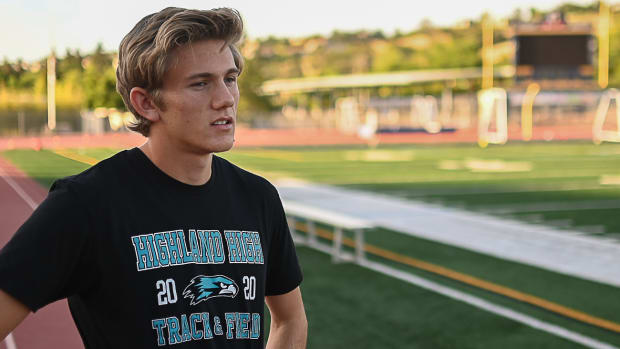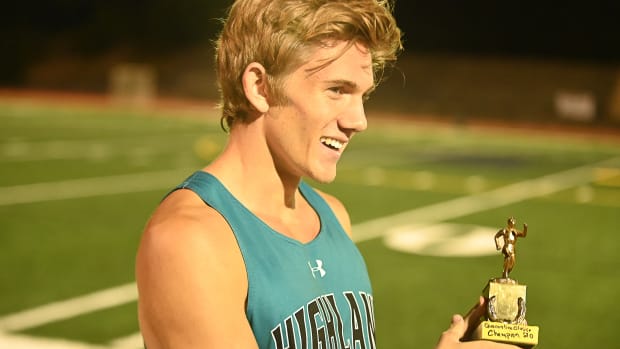New on Sports Illustrated: How A High Schooler Raced Into the Record Books in a Season Without Races
How a small race came together for Leo Daschbach to run 3:59.54 and become the 11th high school boy to break the four-minute barrier in the mile.
Leo Daschbach left it all on the track including the chicken, rice and spinach from dinner as he sprawled out and puked at Oak Ridge High School in El Dorado Hill, Calif. On May 23, the senior from Highland High School (Gilbert, Ariz.) ran 3:59.54 to become just the 11th U.S. high school runner to break the four-minute-mile barrier in an even rarer setting at the moment—an outdoor track race aptly called the Quarantine Clasico.
There was no crescendo from hundreds of fans down the final stretch. With just parents in the stands and a few people who learned of the race’s secret location, Daschbach kicked his way into history.
“It was different considering it was a race environment,” Daschbach says. “I actually preferred it because the noise can make it hard to focus and relax in a race. Without the noise there, I was able to relax, focus and make all the right moves at the right time.”
At the beginning of May, Matt Strangio of Jesuit High School (Calif.) planned to seize upon relaxed lockdown restrictions by California Governor Gavin Newsom in order to pull off an outdoor race when nearly all track competition has been wiped away due to the COVID-19 pandemic. Newsom had said that live concerts and sports would not be held in California until herd immunity and a COVID-19 vaccine are developed. By May 14, 18 of California’s 58 counties were approved to ease into Stage 2 of reopening. According to El Dorado County’s COVID-19 guidelines for Stage 2, people “may recreate together if you can maintain physical distancing of at least six feet.” However, “live audience sports” are
still not permitted.Strangio assembled an Instagram group chat, where the average mile personal best of everyone in the group is under 4:10, and floated the idea of competing with the best milers from California, Arizona, Utah and Colorado. Daschbach was one of the first members invited and quickly committed to racing.
Strangio pulled out of the race due to a shin injury but stayed on as the race director. Oak Ridge High School coach Bob Wright allowed for a small group to use the track. Strangio agreed to let Milesplit, a high school subscription broadcaster and streaming site, broadcast the race and they would pay for the automatic timing system and official to allow the race to comply with official record-keeping guidelines. If eight high school runners broke four minutes in the mile and it was hand-timed, it wouldn’t count.
The National High School Federation keeps official records but recognizes only marks made in season during high school competition. Track and Field News, widely considered “The Bible of the Sport” since 1948, has statisticians Jack Shepard and Mike Kennedy responsible for compiling high school all-time lists. Shepard tells SI that because the Quarantine Clasico met the conditions of timing, officials and runners from multiple schools, it would count toward their lists.

The sub-four mile remains one of high school track and field’s most revered accomplishments. Jim Ryun was the first to accomplish the feat in 1965 with a 3:59.0 as a junior. From 1967 to 2001, no one was able to do it until Alan Webb notched the first on an indoor track and then ran 3:53.43 during the following outdoor season. Webb’s remains the fastest mile by any high schooler to this day, and he went on to set the U.S. record in the mile, 3:46.91. Technological improvements in track surfaces, training and footwear can be partially credited with the recent uptick in high school runners getting faster. Since 2016, the high school sub-four club has grown from five members to 11.
Major sportswear apparel companies like Nike, New Balance, Adidas and Brooks have held annual outdoor track meets to showcase the best high school runners and try to add another member to that club. Due to the COVID-19 pandemic and the cancelation of nearly all outdoor track meets, 2020 looked to be the first year without those opportunities, until Strangio’s all-star group chat of 15 members.
Once a field of eight runners was set, each runner had to fund their own travel and accommodations. Daschbach says his parents and coach were fully supportive of allowing him to make a trip to California to race, so he flew into Sacramento on Friday while his parents drove 12 hours to spectate.
Daschbach stayed in his hotel room for most of Saturday before nerves and stress started developing before that night’s race. He tried some light yoga and meditation to try to get it to dissipate.
“The biggest thing that was making me nervous was that I had really good workouts in the two weeks prior to my last time trial but I ran a 4:07—which was pretty bad,” Daschbach says. “It’s not a bad mile time, but when you want to run 3:59, that’s a bad time to run before a legit attempt.”
Daschbach is still fairly early into his running career. He gave up club soccer after his sophomore year to fully commit to track. He won two Arizona outdoor state titles as a sophomore and then added four more with the 800 meters, 1600 meters, 3,200 meters and 4x800-meter relay as a junior. He ran a 4:03 mile while nearly getting tripped up at the Brooks PR Meet in Seattle to cap his junior season, and the discussion of 3:59 was not far behind.
“The way he runs, he wants to compete,” Highland High School coach David Montgomery says. “He’s not a really big guy into records. He’s just into competing and running to win.”
Daschbach wanted to focus on winning the two mile at the prestigious Arcadia (Calif.) Invitational high school meet in April, where most of the country’s best high school middle distance runners face off. The pandemic canceled those plans and just about all opportunities for him to stake his claim as Arizona’s fastest high school distance runner of all time by wiping away the AIA State Track and Field Meet.
Most “races” since the coronavirus pandemic shutdown have consisted of time trials where runners compete solo with self-timing and no starter or official. Daschbach time-trialed a 4:03.7 mile on April 13 and then a 1:49.85 for 800 meters, which both would have been Arizona state high school records but do not count toward anything but a sign of fitness.
In the shortened outdoor season, Daschbach beat all of Highland’s sprinters in a hand-timed 400-meter time trial with a low 49-second quarter. Last year, he made note of Ethiopian distance runner Yomif Kejelcha’s running a 6x400-meter workout with 500 meters of jogging recovery between reps just 10 days before he broke the indoor mile record in 3:47.01. Daschbach mimicked the workout nine days before his sub-four and ran each lap between 54 and 56 seconds. On May 18 and in one of the few times Montgomery attended a socially distanced practice, he timed Daschbach in an 800m-600m-400m-300m-200m workout (90 seconds of rest between intervals) where he split 2:02, 1:29, :54, :40 and :27.
“After that I knew he was ready,” Montgomery says. “This kid has been getting up at 6 o’clock in the morning, doing all his workouts, hopping fences to do these workouts, and he texted me when all this lockdown started, ‘Coach, I’m still hungry. Give me workouts.’ He’s been doing it for a few months now, but the fuel from social media really fueled his desire to really do well this spring. Without a season, he had something to prove.”

Message boards were the first internet microscope for high school phenoms like Webb. When Lukas Verzbicas broke four minutes for the mile in New York City in 2011, SI noted his 5,000 Facebook friends and his Twitter account. Now, in addition to 20 state titles among the Quarantine Clasico competitors, the field of eight runners had more than 36,800 Instagram followers combined. Milesplit promoted the race to its own 215,000 Instagram followers, so getting tagged in posts to hype up the race or Instagram stories discussing rivalries or predictions only added to the internet fervor in a time when many are craving any live sports action.
“I was scared to let people down,” Daschbach says. “I didn’t have too much confidence because of my last time trial. It was a mix of those things forming together and created this big ball of scared and nervous energy. Prior to the race, I had a bad headache during my warmup laps. I was just able to focus and dial in my mentality and talk to myself to get myself hyped up. The headache went away during the strides right before the race, so I felt good during the race.”
Despite having pacers and all the talent in the field, the race went out too slow through halfway in 2:02. With 600 meters left, he heard the PA announcer say they needed to run 1:27 to break four minutes, and he knew that was doable based on his workouts. Daschbach’s initial race plan was to take the lead heading into the final lap but his 5' 10", 140-pound frame didn’t make the pass until there were just 250 meters remaining. He managed to spot the clock just before the finish line and knew he got under.
“I do think my fitness was a little faster than that and that’s why I was able to get it,” he says. “Those splits were not ideal splits. I think the only reason why I was able to close in :56 and I was able to save it was the fact that I was a little fitter than 3:59 that day. If it had been paced better, two seconds faster is too generous, but I do think I could have run at least one second faster.”
Daschbach’s personal best will remain that way for a while despite another race being planned by Strangio and his friends for June 27. Daschbach will do a solo 800-meter time trial on Saturday before taking a break and vacation (back) to California and then starting his summer training for his freshman cross-country season at the University of Washington.
“Alan Webb went on to set the American mile record,” Daschbach says. “What I want to do is keep moving forward, so when people talk about Leo Daschbach they don’t just say, ‘He was fast in high school,’ but they say, ‘He’s fast now, and he was fast in high school.’”

Comments
Post a Comment